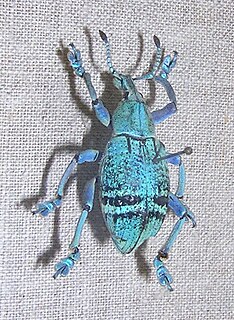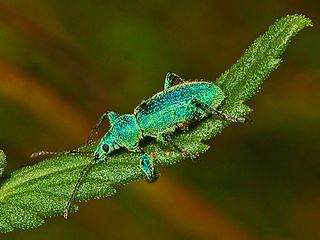
The Curculionidae are the family of the "true" weevils. They are one of the largest animal families, with 6,800 genera and 83,000 species described worldwide. They are the sister group to the subfamily Brentidae

Otiorhynchus is a large genus of weevils in the family Curculionidae. Many species of the genus, particularly the black vine weevil and the strawberry root weevil, are important pests, both as larvae and as adults. Larvae feed on plant roots. Adults are flightless with fused elytra and feed at night on plant foliage. In many species of the genus at least some races are polyploid and parthenogenetic, while the rest of the races and species are diploid and bisexual. Otiorhynchus weevils, particularly O. scaber, have been a popular subject for studies of the evolution of parthenogenesis. The genus is native to the Palearctic region. However, sixteen species were inadvertently introduced to North America and have become widespread there.

Sitona is a large genus of weevils in the family Curculionidae native to the Nearctic and Palaearctic regions. Over 100 species have been described. Sitona is easily distinguished from related genera by flat, recumbent scales on the mandibles, by the absence of an oval scar on the mandibles, by short and broad rostrum with a deep, longitudinal, median groove, and by dense scales on the body.

The Entiminae are a large subfamily in the weevil family Curculionidae, containing most of the short-nosed weevils, including such genera as Otiorhynchus, Phyllobius, and Sitona. Some of these weevils are notorious pests of major economic importance.

Eupholini is a weevil tribe in the subfamily Entiminae.
Geonemini is a weevil tribe in the subfamily Entiminae.
Hormorini is a weevil tribe in the subfamily Entiminae.
Nastini is a weevil tribe in the subfamily Entiminae.
Omiini is a weevil tribe in the subfamily Entiminae.
Oosomini is a weevil tribe in the subfamily Entiminae.
Ophryastini is a weevil tribe in the subfamily Entiminae.
Ophtalmorrhynchini is a weevil tribe in the subfamily Entiminae.
Peritelini is a weevil tribe in the subfamily Entiminae.

Phyllobiini is a weevil tribe in the subfamily Entiminae.

Polydrosini is a weevil tribe in the subfamily Entiminae.

Tanymecini is a tribe of broad-nosed weevils in the beetle family Curculionidae. There are about 12 genera and at least 20 described species in Tanymecini.

Barypeithes sulcifrons is a species of weevil native to Europe.

Myllocerus undecimpustulatus, known generally as the Sri Lanka weevil or yellow-headed ravenous weevil, is a species of oriental broad-nosed weevil in the beetle family Curculionidae.

Naupactus cervinus, the Fuller rose beetle, is a species of broad-nosed weevil in the family Curculionidae.

Tropiphorus elevatus is a species of broad-nosed weevil in the beetle family Curculionidae.












